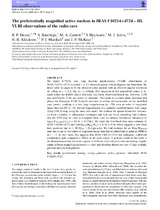The preferentially magnified active nucleus in IRAS F10214+4724 - III. VLBI observations of the radio core
Date
2013Author
Deane, Roger P.
Rawlings, S.
Jarvis, Matt
Garrett, M. A.
Heywood, Ian
Klöckner, H. R.
Marshall, P. J.
McKean, J. P.
Metadata
Show full item recordAbstract
We report 1.7GHz very long baseline interferometry (VLBI) observations of IRAS F10214+4724, a lensed z = 2.3 obscured quasar with prodigious star formation. We detect what we argue to be the obscured active nucleus with an effective angular resolution of <50pc at z = 2.3. The S1.7 =210µJy (9σ) detection of this unresolved source is located within the Hubble Space Telescope rest-frame ultraviolet/optical arc, however, 100 mas northwards of the arc centre of curvature. This leads to a source-plane inversion that places the European VLBI Network detection to within milliarcseconds of the modelled cusp caustic, resulting in a very large magnification (μ ∼70), over an order of magnitude larger than the CO (1→0) derived magnification of a spatially resolved Jansky Very Large Array (JVLA) map, using the same lens model. We estimate the quasar bolometric luminosity from a number of independent techniques and with our X-ray modelling find evidence that the AGN may be close to Compton thick, with an intrinsic bolometric luminosity of log10( Lbol, QSO /L ) = 11.34 ± 0.27dex. We make the first black hole mass estimate of IRAS F10214+4724 and find log10(MBH/M ) = 8.36 ± 0.56 which suggests a low black hole accretion rate (λ = ˙M/ ˙ MEdd ∼3±7 2 percent). We find evidence for an MBH/Mspheroid ratio that is one to two orders of magnitude larger than that of submillimetre galaxies (SMGs) at z ∼ 2. At face value, this suggests that IRAS F10214+4724 has undergone a different evolutionary path compared to SMGs at the same epoch. A primary result of this work is the demonstration that emission regions of different sizes and positions can undergo significantly different magnification boosts (>1dex) and therefore distort our view of high-redshift, gravitationally lensed galaxies.

